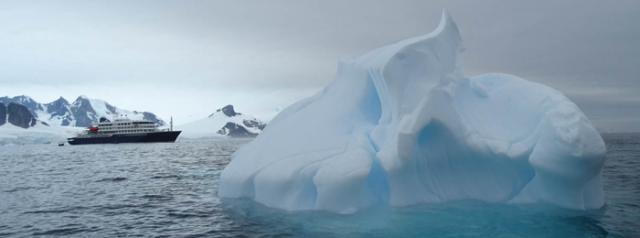The Holbrook Explorer

Photo Gallery: A Journey to the “End of the Earth”
Photo Gallery: A Journey to the “End of the Earth”
Earlier this year, Holbrook’s Debbie Jordan embarked with a group of travelers on an expedition to the “White Continent” – Antarctica. Here, she shares her experience in words and pictures.
I believe Antarctica is the most photogenic place I’ve ever been, in all my travels. From the thrill of crossing the polar circle and seeing our first icebergs, to up-close views of orcas, humpbacks, five types of seals, and three penguin species, our adventure was truly the trip of a lifetime.

Our journey began at the southern tip of Argentina in Ushuaia, “the end of the world.” This is the view of Ushuaia Bay from my hotel room, with one of the many daily cruise ships that depart during the summer. Ships carrying 500 passengers or more are not allowed to land in Antarctica, but they can still navigate the waters.

Here’s our group, and there’s our ship, the m/v Hondius (the good-looking blue one)! Can you feel our excitement? We’re just about to board the bus to the pier and embark on our adventure.

These are teenage penguins heading to the sea at Port Lockroy. This photo presented itself when I was buying stamps to post my cards from the world’s southernmost post office (don’t expect delivery for about a month as they have to go to England first!). The clerk called my attention to the baby penguins being herded toward the water as a group.

We're cruising through the Lemaire Channel. Nicknamed Kodak Gap for a reason, this illustrates how diverse and beautiful the landscape is here. From the granite on the left to the blue glacier ice on the right, there are many colored algaes in between.

This leopard seal seems to be perpetually smiling! But beware, they are solitary and aggressive. Unlike other members of the seal family, the leopard seal’s diet includes other Antarctic marine mammals, including the crabeater seal, Weddell seal, and Antarctic fur seal. They also eat penguins, fish, and cephalopods. In all, we saw five types of seals, including the rare Ross seal, on our first day.

Our first landing was at Detaille Island and was a bit treacherous, especially after being at sea for two days. Landing in Antarctica requires some agility while wearing heavy clothes, a life jacket, and rubber boots. Having good balance is important!

The bird in the back is called a Snowy Sheathbill, the only land bird native to the continent. They migrate north to Tierra del Fuego in the winter and are often called "garbage birds" because they scavenge everything, even feces. You can see he is eyeing this mother Gentoo Penguin, which is feeding krill to her chick.

The next thing I knew, he jumped on the baby’s back and grabbed a mouthful! It is unusual to see the krill because the chicks put their heads way up into mom’s bill (for good reason!).

These Adelie Penguins are the smallest of the three species we encountered. Unless they get eaten by a leopard seal, these medium-sized penguins (27 inches tall) can live up to 18 years. They give a little perspective to the giant ice sculptures in the background.

Two-thirds of most icebergs are underwater. Zodiac drivers are careful not to get too close, as they can unexpectedly flip over. I witnessed a couple of bergs that just started rocking wildly for no apparent reason.

The Chinstrap Penguins were my favorites, especially the babies losing their fluff and getting their adult feathers. Slightly bigger than Adelies, Chinstraps can nest in huge colonies, such as one containing over 1 million birds in the South Sandwich Islands.

Great light makes great pictures. Blessed by wonderful weather, we had no shortage of good light, including our last afternoon—re-entering the Beagle Channel after our second smooth crossing of the Drake Passage. We were so lucky!

Instead of departing immediately after our cruise, we stayed another night in Ushuaia and visited Tierra del Fuego National Park, where we encountered unusual vegetation, great birds, and beautiful landscapes. This was truly the trip of a lifetime!

